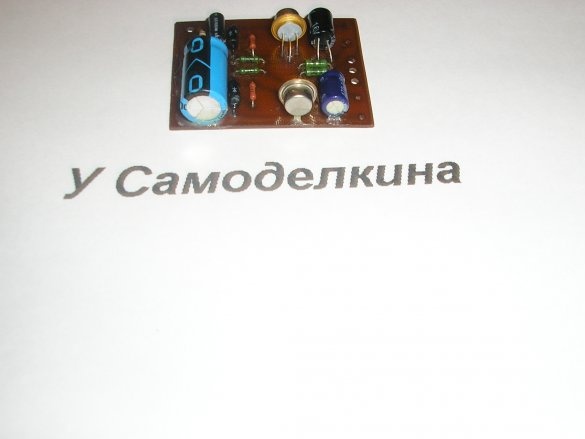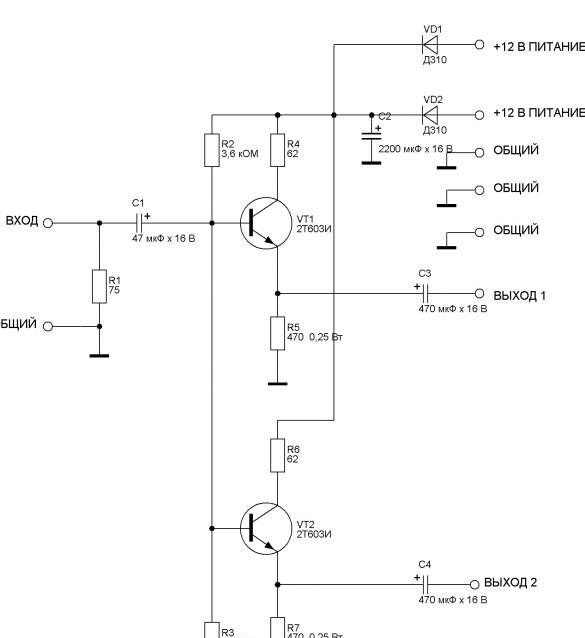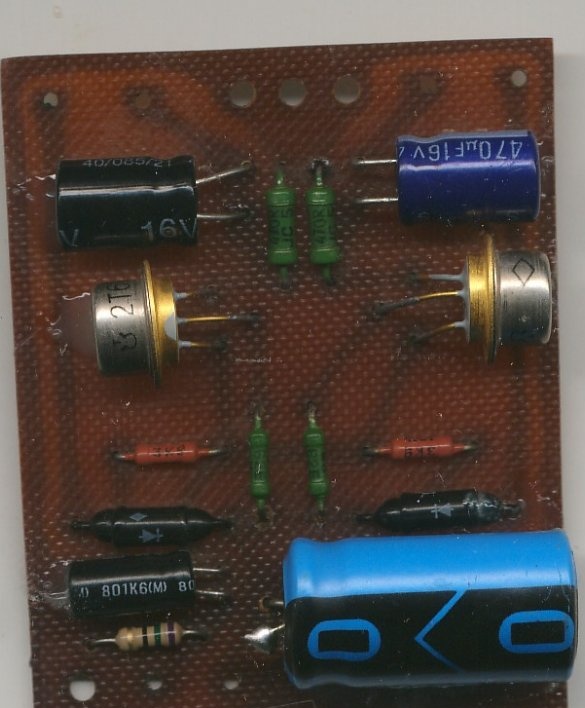Hello, dear authors, journalists, readers!
My homemade may be useful to those involved in audio, video and other signals.
It may be necessary to send an audio or video signal from one source to several consumers simultaneously, over a long distance, without distortion and interference, and through poor wires and cables.
For those who want to repeat this product, I will say. Basic knowledge, a minimum of instruments and tools are required.
The author, in the development and manufacture, applied the following:
Frequency counter electron-counting RFZ – 07–002
Oscilloscope S1-73
Laboratory power supply unit MARS
The device of the telemaster LASPI-TT-01
Functional generator L30
Multimeter M890G
Avometer Ts20
SAMSUNG VCR ELECTRONICS BM1230
TV sets RECORD, SANYO, TELEFUNKEN
Musical centers JVS, PANASONIC, AIWA.
Resistor Set
Cords, cables, wires. RK-75, TRP, KSPV.
Soldering irons are different.
Solder, ferric chloride, rosin, solvent, glue.
The tools are different.
Let's start with the concept.
I laid the basis for its important properties of the so-called emitter follower ..
It does not amplify the voltage signal, it even weakens negligibly, by 1 - 2 percent.
But, amplifies the current and power.
In addition, it has a low output impedance.
Regarding the output resistance of the emitter follower. Do not think that it is equal to the resistance in the emitter of the transistor. It is determined by many factors, for example, the gain of the transistor, the current through it.
An output impedance of less than one ohm can be achieved.
However, it is almost impossible to calculate all the parameters, I selected empirically.
Not prone to self-excitation.
With regards to self-excitation. The gain of the emitter follower is slightly less than unity, and for generation to occur, positive feedback with a coefficient greater than unity is needed.
Good frequency response.
Regarding the frequency response. It is characteristic of cascades with low gain.
As a result, we get this.
Successfully distributing a broadband signal to several consumers. Suppress interference and interference on long lines with low output impedance.
So (on the example of a video signal).
The signal comes, for example, from a DVD player to the terminating resistor R1. Its resistance is 75 ohms (accepted for video signals). Through the isolation capacitor C1, the signal is supplied to the bases of two high-frequency transistors VT1 and VT2, connected according to the emitter follower circuit.This circuit is also called the common collector, OK. Do not confuse with an open collector, also OK.
I chose transistors 2T603 according to the following criteria. High frequency, sufficient current transfer coefficient, sufficient power dissipation.
The offset at their bases is specified by the divisor R2 R3. The application of the OK circuit allowed us to combine the base of transistors and reduce the number of circuit elements.
The emitter loads are resistors R5 and R7.
Resistors R4 and R6 in the collector circuit of the transistors are current limiters.
From the loads through the capacitors C3 and C4, the signals are sent to consumers. In this scheme, at least two consumers (TV) can be connected to each output. In practice, more.
About nutrition:
In this version, I made two power inputs for extra reliability.
For this, diodes VD1 and VD2 are used. They also serve to protect against power surges.
It looks like this .. If one power supply fails, one of the diodes is locked and does not allow the working unit to direct power to a non-working one. The same thing, with the addition, the diode is locked and does not allow the voltage of reverse polarity to get on the circuit and disable it.
The choice fell on the D310, as they have a small voltage drop and are designed with a margin for the current consumed by the device.
Can be replaced with modern diodes (Schottky).
A view of the assembled circuit board is shown in the photo.
This photo shows that it turned out to be very compact. For comparison, I put a matchbox next to it.
I drew this printed circuit board by hand, the tracks are not as beautiful as they should be. But, I considered it fair to show. It is even more obvious that I bred it without a computer, but all the details are beautifully and optimally arranged and there are at least tracks, no jumpers.
Now for the details.
Here is the pinout of the applied transistors.
Of course, it is not necessary to use 2T603I, any KT603 will go, the final letter is not so important.
Moreover, the KT646B and KT972A will work, in my opinion their conclusions will fit this board, they just have flat cases, not round ones.
Now, if you transmit sound.
The input resistor R1 must be increased to 10 kOhm (accepted for audio signals). The number of consumers by sound will be dozens. All capacitor capacities, except those in the power filter, can be reduced by a factor of ten.
By video and sound.
It must be understood that if we want to transmit S video or component video, the number of such boards must be increased according to the number of channels.
The same thing, if the sound is stereo, then you need two boards.
Want to add. This system allows you to transmit and pulse signals.
You, of course, have a question, but how can this be avoided by interference? The low output impedance of the emitter follower does not allow them to visit. And your signal goes perfectly in line.
I have another similar homemade product. Next time I will present it to your attention.
There are fewer parts in it, for example, a transistor is only one and the output is only one. However, much more consumers can be connected to it.
I hope my article will be useful to you.
Sincerely, author.







